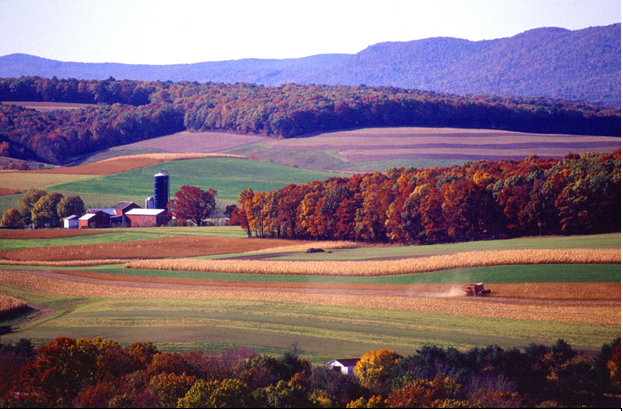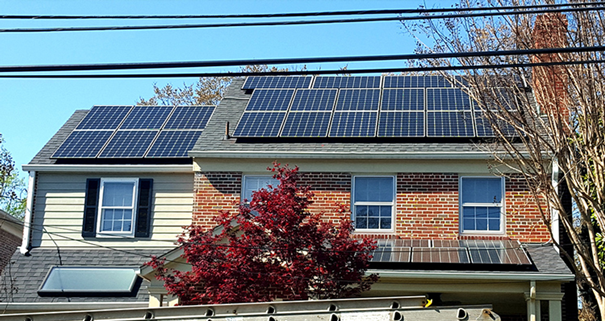Local Solar Facility Siting Ordinances
Note: to access the county codes discussed in the following case study, we recommend that you access the Smart DG+ County Zoning Guide at dnr.maryland.gov/pprp/Pages/smartdg.aspx.
Solar Facility Siting Case Study
Jurisdiction: Frederick County
Type: Utility-Scale, Undeveloped Land
Zoning Used: Floating Zone
Process: Government-Driven
Description of Process:
Approximately six years ago, Frederick County created legislation to address the issue of regulating solar energy systems. The impetus for the zoning update came from the large number of applications for solar energy facilities, some of them for hundreds of acres, in Frederick’s Priority Preservation Area (PPA) and other areas of prime agricultural soil. The stream of applications came in response to public concerns and an upcoming deadline on federal tax credits, which were later extended. The agricultural district at the time was also being considered for other commercial activities, including breweries, wineries and tasting rooms, medical marijuana, etc.
The County Executive ordered a moratorium on solar applications not already approved by the Board of Appeals. The president of the County Council and the legal staff drafted the zoning regulations. Public input came during the County Council’s public hearing.
Farmers, including the Agricultural Business Council and the Farm Bureau, lined up on both sides of the zoning proposal, the main objection being that it was too restrictive. Representatives of the solar industry also found the new regulations too restrictive. As a result, the first draft of the statute was revised. Historic preservation advocates endorsed the prohibition on locating solar facilities on the Journey Through Hallowed Ground National Heritage Area on either side of Route 15. The general public generally has not been interested until they see a notice of a solar proposal in their neighborhood and then they have registered their opposition.
As for solar installations on other types of land uses, solar panels have not been installed in parking lots, except for a small installation at Mount St. Mary’s University.
If the existing zoning is revised, the drafting would involve a variety of interests to prevent the bill from being tabled by the County Council after a public hearing. The goal would be to have consensus before getting to the public hearing; the potential for this to occur is in workshops prior to moving the text amendment forward.
Currently, the County Council must approve a solar facility use by designating a floating zone and the specifics of the development are then processed through the site plan approval at the Planning Commission.
Best Practices Identified by Frederick County:
Restrictions on the use of prime soils; a development limit of 10% on individual properties; prohibition on solar panels in Rural Legacy Areas, Priority Preservation Areas, or on land under easement; a two-mile buffer from the centerline of the right-of-way of U.S. Route 15 in the Journey Through Hallowed Ground National Heritage Area.
Specifics Regarding Zoning Ordinance:
Zoning for solar collection facilities in Frederick County was contained in Bill #17-07, which became effective on July 15, 2017.
Accessory Solar Facilities Allowed in All Zoning Districts:
A “Solar Facility, Accessory is a permitted use in all zoning districts” and a “Solar Facility, Community Energy Generating System, is an accessory use in all zoning districts and the facility may be located on a different parcel of land than that of the subscribers…" [emphasis added].1
Commercial Solar Facilities Allowed as Principal Use Only in Industrial Districts:
Commercial Solar facilities are allowed as principal permitted use subject to site development plan approval in the Limited Industrial (LI) District and General Industrial (GI) District.2

In a densely populated state such as Maryland, land is in demand for many reasons…
including the production of food and fiber for Marylanders.
- The minimum lot area is 20,000 sq. ft. in the LI District and one acre in the GI District. The following lot requirements apply to both zones: Lot Width, 200 feet; Front Yard, 50 feet; Side Yard, 50 feet; Rear Yard, 50 feet. Height: 30 feet.
- Justification for why the site was selected is required.
- A “[g]lint and glare analysis of… impacts on nearby properties, roadways, and airports” shall be provided.
- “The appearance and visual impact of the solar facility shall be minimized by the use of screening.”
- The project must be compliant with all federal and state laws and regulations, including a CPCN, if required.
- “All solar facilities and panel disconnects must be mapped and registered with the Frederick County Division of Fire and Rescue Services.”
- Approval of the facility terminates if it is inactive or disconnected from the grid for six months. The property owner must remove the facility within 90 days and “shall ensure the solar facility removal and disposal by posting an acceptable monetary guarantee with the County…plus a 15% contingency.”
Commercial Solar Facilities Allowed on Rural Land as a Floating Zone:3
The major stipulations in the ordinance regarding a floating zone for commercial solar facilities on rural land include the following:
- The land must be zoned Agriculture and have an “agricultural/rural” land use designation in the comprehensive plan.
- The project cannot exceed 10% of the farm’s tillable acreage, or 75 acres; the minimum size of the tract or tracts is 10 acres and the maximum 750 acres. (Currently there is no countywide cap on the number of acres that can be used for solar projects.)
- It cannot sit on prime farm soils or be located in a Priority Preservation Area or Rural Legacy Area, or under easement;
- It cannot be contiguous to growth areas identified in Frederick County’s Comprehensive Plan.
- The site may not “be located within two miles of the centerline of the right-of-way of U.S. Route 15, outside the Frederick City limits from the Pennsylvania border to the Virginia border, that Route having been designated as part of the Journey Through Hallowed Ground National Heritage Area,” unless the applicant can show that the facility will not be visible from Route 15.
- The proposed project will be evaluated for impacts upon nearby properties and its compatibility with surrounding properties and viewscapes from public parks and roadways.
- The optimal site for a commercial solar project should be able to connect to the grid while minimizing “the visual impact of the project on surrounding properties and those traveling on public roadways.”
- “[T]he proposed project will be compatible with the existing and customary uses on adjoining and neighboring properties and in the Agriculture zone in terms of size, scale, style and intensity.”
- “A 25 foot deep buffering and screening area [which may be located with the setback areas] shall be provided along common property lines…and all adjoining residentially zoned property and along all adjacent roadways. The…area may include a combination of berms, predominantly evergreen species at least 5 feet in height…or fencing to be determined by the County Council….”
- The project must comply with all federal and state regulations, including CPCN (if required) and county forest resource and/or environmental regulations.
- “All solar facilities and panel disconnects must be mapped and registered with the Frederick County Division of Fire and Rescue Services.”
- Approval of the facility terminates if it is inactive or disconnected from the grid for six months. “The property owner must remove the facility within 90 days… [and] ensure…the solar facility removal and disposal by posting an acceptable monetary guarantee with the County…plus a 15% contingency.”
- Other conditions may apply “to protect the intent of the agricultural/rural land use designation.”
- “Prior to submitting an application…the applicant shall publicize the proposed application… including a map showing the site and a one-mile radius. The applicant shall hold a meeting [with]…members of the surrounding community regarding potential impacts of the project. Written notice of the meeting shall be provided to all abutting property owners and any homeowners/community associations within a one-mile radius of the property.”
- The required maps include a “vicinity map at a scale of one inch equals 2,000 feet or more…indicating the location of the property with respect to surrounding property and streets” and an “environmental features map of the property showing the existing surface of the land and the location of soil types and natural features such as streams, rock outcrops and wooded areas, at a minimum of 5 foot contour intervals, unless otherwise specified.”
- “A phasing schedule describing the timing and sequence of development.”
- “[G]lint and glare analysis of… impacts upon nearby properties, roadways, and airports”

Local zoning often allows home solar systems by right.
- “…[a] justification statement addressing each of the approval criteria as well as the following:
- Relationship of uses within the project and with existing uses in the neighborhood;
- The timing of the construction of the project as it relates to the provision of facilities and services;
- A statement identifying all incidental accessory uses and activities associated with the primary use of the property including hours of operation, frequency of activity, and average number in attendance.”
- The county does not require pollinator-friendly plants underneath solar installations under the current zoning ordinance; however, they are becoming the industry practice for community systems (which are less than two megawatt).
1 These two provisions can be found in Part I: Frederick County Code, Chapter 1-19 Zoning, Article VIII: Specific Use Regulations, Division 2: Accessory Uses—205.4: Solar Facility, accessory and 2.5.5: Solar facility, community energy generating system, respectively.
2 The information in this section’s bullet points comes from Part I: Frederick County Code, Chapter 1-19 Zoning, Article VI: District Regulations, Division 1: Design Requirements and Modifications; and Article VIII: Specific Use Regulations, Division 4: Permitted Uses.
3 The zoning provisions in this section can be found in Part I: Frederick County Code, Chapter 1-19 Zoning, Article X: Optional Methods of Development, Division 7: Solar Facility, Commercial Floating Zone District